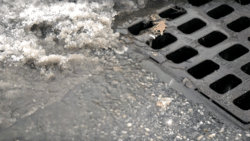In our February News to Us read about threats to river and drinking water quality in the Huron and across the state, including road salt, PFAS, hexchrome, and dioxane. This month’s News to Us also features articles exploring solutions to the state’s water challenges, including new funding, pending legislation, improved outdoor equity, and local cleanups.
Road salt, a stealthy pollutant, is damaging Michigan waters
Salting sidewalks and roads in the winter for cars and pedestrians impacts aquatic ecosystems. Salt disrupts the food web, inhibiting growth, and poisoning songbirds. In response to these salt-induced impairments on state waters, the Michigan Department of Environment, Great Lakes, and Energy issued its first water quality standards for chloride at eight stream sections across southeast Michigan in 2019. However, regulatory plans to cap chloride pollution, also called a total maximum daily load (TMDL), have not been developed for those areas. To find out more about at-home deicing best practice, click here.

For Ann Arbor water managers, ongoing battle to keep toxic chemicals at bay
Due to ongoing and emerging threats to its drinking water from contaminants such as PFAS, hexchrome, and dioxane, the City of Ann Arbor has invested millions of dollars in infrastructure upgrades, maintenance, and staff time to ensure safe drinking water for its residents. With federal and state drinking regulations lagging behind, the City maintains a proactive and cautious approach to safeguard the drinking water from the next inevitable emerging contaminant. For more on water regulatory shortcomings related to PFAS, read a recent blog by HRWC’s Dan Brown.
$25M to avert Michigan water shutoffs inspires hope for lasting fix
With changing leadership in Lansing and $25 million in new water shutoff prevention funding, Michigan drinking water advocates are hopeful for meaningful progress towards increased drinking water accessibility and affordability. The legislature also recently introduced a bill declaring water a human right and requiring state agencies to “employ all reasonable means” to make that happen. In addition, Democrats are developing a legislative package with policy solutions and funding opportunities to assist utilities in developing affordable water rate structures.
Outdoor equity heading in the right direction
The Michigan Department of Natural Resources (MDNR) is actively working to make outdoor recreational areas more accessible to historically underserved communities in Michigan. MDNR found that the location of facilities, absence of facilities, and discomfort have been barriers to equitable outdoor access across the state. With a focus on Detroit and Flint, MDNR is implementing new programming and constructing a new state park to improve outdoor equity for people of color.
Students jump into river cleanup with both feet
With support from Michigan Clean Water Corps (MiCorps) and the City of Dexter, two Dexter High School students organized two community cleanups along the Huron River in 2022. This piece from the Michigan Department of Environment, Great Lakes, and Energy discusses the impact of local community clean ups — like the one in Dexter — in removing thousands of pounds of trash from Michigan waterways. Applications are open until March 7th for the 2023 MiCorps Volunteer Stream Cleanup Program grants.



